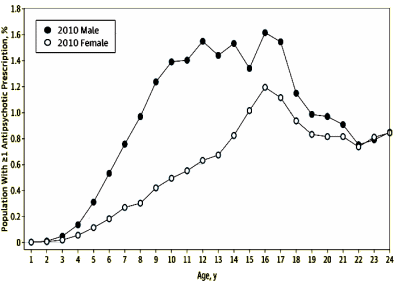When Risperdal® [Risperidone] came along in 1994, it was widely hoped [and hyped] that it would release patients from the heavy and sometimes dangerous side effect burden of the earlier neuroleptic medications. One of Janssen’s targeted indications was in to control disruptive behaviors in intellectually impaired children. This RCT was completed in 1998, and used in a submission to the FDA…
by Michael G. Aman, Ph.D., Goedele De Smedt, M.D., Albert Derivan, M.D., Ben Lyons, Ph.D., Robert L. Findling, M.D., and the Risperidone Disruptive Behavior Study Group
American Journal of Psychiatry 2002 159:1337-1346.
Objective: The short-term efficacy and safety of risperidone in the treatment of disruptive behaviors was examined in a well-characterized cohort of children with subaverage intelligence.
Method: In this 6-week, multicenter, double-blind, parallel-group study of 118 children [aged 5-12 years] with severely disruptive behaviors and subaverage in- telligence [IQ between 36 and 84, inclusive], the subjects received 0.02-0.06 mg/kg per day of risperidone oral solution or placebo. The a priori primary efficacy measure was the change in score from baseline to endpoint on the conduct problem subscalc of the Nisonger Child Behavior Rating Form.
Results: The risperidone group showed significantly greater improvement than did the placebo group on the conduct problem subscale of the Nisonger Child Behavior Rating Form from week 1 through endpoint [change in score of -15.2 and -6.2, respectively]. Risperidone was also associated with significantly greater improvement than placebo on all other Nisonger Child Behavior Rating Form subscales at endpoinl. as well as on the Aberrant Behavior Checklist subscales for irritability, lethargy-social withdrawal, and hyperactivity; the Behavior Problems Inventory aggressive -destructive behavior subscale; a visual analogue scale of the most troublesome symptom; and the Clinical Global Impression change score. The most common adverse effects reported during risperidone treatment were headache and somnolence. The extrapyramidal symptom profile of risperidone was comparable to that of placebo. Mean weight increases of 2.2 kg. and 0.9 kg occurred in the risperidone and placebo groups, respectively.
Conclusions: Risperidone was effective and well tolerated for the treatment of severely disruptive behaviors in children with subaverage IQ.
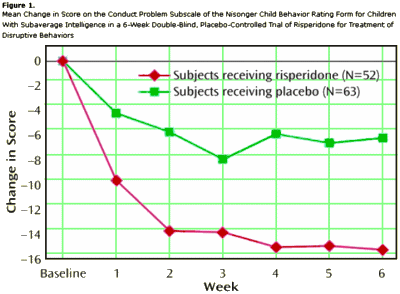
… that was denied, not because of lack of efficacy, but because the FDA felt the indication was too broad and might lead to the overmedication of kids. This Janssen study was repurposed, rewritten [ghost written], and republished under Dr. Joseph Biederman’s name in 2006 as part of his series on the treatment of the
Bipolar Child [
bipolar kids: biedermania and super angry/grouchy/cranky irritability…]. Janssen was later fined for off-label promotion and other forbidden marketing practices.
In the intervening decades, the Atypical Antipsychotics haven’t lived up to those early expectations, at least in a medical sense. But they became blockbusters at the marketplace – one or another of them dominating the sales charts for years. While the side effect profiles differ from those of the first generation drugs, they are hardly benign. And the feared overmedication of children moved out of the domain of future worry into our current reality. This next article by Olfson et al is a new population survey of antipsychotic medication use in youth that aims to flesh out that current reality [the reason I started with Aman et al’s early trial will become obvious]:
by Mark Olfson, MD, MPH; Marissa King, PhD; Michael Schoenbaum, PhD
JAMA Psychiatry. online July 01, 2015. doi:10.1001/jamapsychiatry.2015.0500.
Importance Despite concerns about rising treatment of young people with antipsychotic medications, little is known about trends and patterns of their use in the United States.
Objective To describe antipsychotic prescription patterns among young people in the United States, focusing on age and sex.
Design, Setting, and Participants A retrospective descriptive analysis of antipsychotic prescriptions among patients aged 1 to 24 years was performed with data from calendar years 2006 [n = 765,829], 2008 [n = 858,216], and 2010 [n = 851,874], including a subset from calendar year 2009 with service claims data [n = 53,896]. Data were retrieved from the IMS LifeLink LRx Longitudinal Prescription database, which includes approximately 60% of all retail pharmacies in the United States. Denominators were adjusted to generalize estimates to the US population.
Main Outcomes and Measures The percentage of young people filling 1 or more antipsychotic prescriptions during the study year by sex and age group [younger children, 1-6 years; older children, 7-12 years; adolescents, 13-18 years; and young adults, 19-24 years] was calculated. Among young people with antipsychotic use, percentages with specific clinical psychiatric diagnoses and 1 or more antipsychotic prescriptions from a psychiatrist and from a child and adolescent psychiatrist were also determined.
Results The percentages of young people using antipsychotics in 2006 and 2010, respectively, were 0.14% and 0.11% for younger children, 0.85% and 0.80% for older children, 1.10% and 1.19% for adolescents, and 0.69% and 0.84% for young adults. In 2010, males were more likely than females to use antipsychotics, especially during childhood and adolescence: 0.16% vs 0.06% for younger children, 1.20% vs 0.44% for older children, 1.42% vs 0.95% for adolescents, and 0.88% vs 0.81% for young adults. Among young people treated with antipsychotics in 2010, receiving a prescription from a psychiatrist was less common among younger children [57.9%] than among other age groups [range, 70.4%-77.9%]. Approximately 29.3% of younger children treated with antipsychotics in 2010 received 1 or more antipsychotic prescriptions from a child and adolescent psychiatrist. Among young people with claims for mental disorders in 2009 who were treated with antipsychotics, the most common diagnoses were attention-deficit/hyperactivity disorder in younger children [52.5%], older children [60.1%], and adolescents [34.9%] and depression in young adults [34.5%].
Conclusions and Relevance Antipsychotic use increased from 2006 to 2010 for adolescents and young adults but not for children aged 12 years or younger. Peak antipsychotic use in adolescence, especially among boys, and clinical diagnosis patterns are consistent with management of developmentally limited impulsive and aggressive behaviors rather than psychotic symptoms.
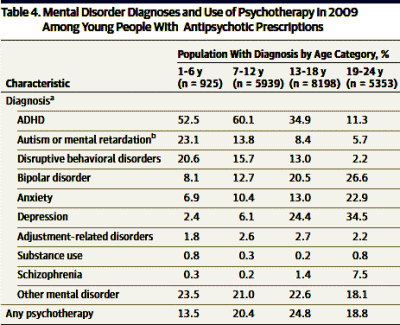
I’ve spent a couple of days reading over this article and its companion editorial. I suppose I wanted to find something profound to say about it, or maybe decry what it has to say in some new way, or even find some new target to blame. But I can’t beat the authors’ conclusion:
Peak antipsychotic use in adolescence, especially among boys, and clinical diagnosis patterns are consistent with management of developmentally limited impulsive and aggressive behaviors rather than psychotic symptoms.
In the text they go on to make recommendations:
Clinical policy makers have opportunities to promote improved quality and safety of antipsychotic medication use in young people through expanded use of quality measures, physician education, telephone- and Internet-based child and adolescent psychiatry consultation models, and improved access to alternative, evidence-based psychosocial treatments.
This paper documents a simple fact – what used to be called antipsychotic medication is being used as a behavior control aid in children and adolescents, much like Aman et al discussed using it in the earliest of days. The likelihood that these latter suggestions will be implemented or that they would make much difference if they were probably approximates zero without a palpable change in the current climate of child and adolescent psychiatry and its professional organizations…
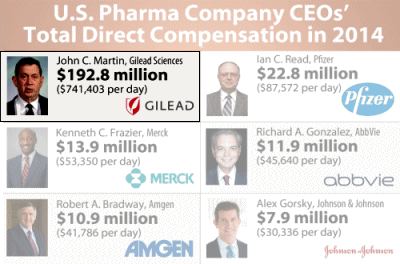
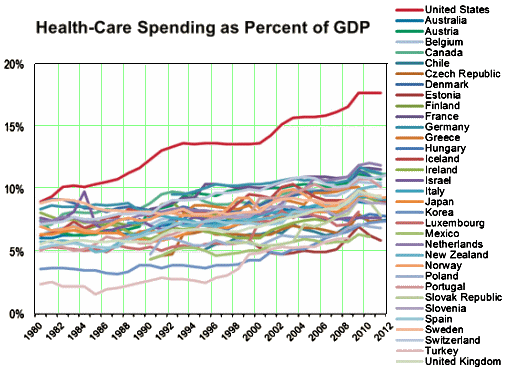


 So rather that approach this scandal as a search for a few "bad apples," the APA would do well to borrow the watchword of Cosgrove’s and Whitaker’s new book, Psychiatry Under the Influence, and take a long look at the "bad barrel" aspect of their own APA. This was a massive ethical infraction, originating in the upper levels of the APA with those in charge of setting the profession’s ethical standards, one that involved two APA Presidents. This hardly qualifies the American Psychological Association for any moral high ground in the guild wars that have plagued the mental health specialties for decades. Institutional Corruption? Sure sounds that way to me…
So rather that approach this scandal as a search for a few "bad apples," the APA would do well to borrow the watchword of Cosgrove’s and Whitaker’s new book, Psychiatry Under the Influence, and take a long look at the "bad barrel" aspect of their own APA. This was a massive ethical infraction, originating in the upper levels of the APA with those in charge of setting the profession’s ethical standards, one that involved two APA Presidents. This hardly qualifies the American Psychological Association for any moral high ground in the guild wars that have plagued the mental health specialties for decades. Institutional Corruption? Sure sounds that way to me…  The investors, which collectively manage about $3.8 trillion, plan to meet with drug makers in which they invest to ensure that trials are registered and results are reported, according to Sile Lane, campaign director at Sense About Science, a non-profit that launched the
The investors, which collectively manage about $3.8 trillion, plan to meet with drug makers in which they invest to ensure that trials are registered and results are reported, according to Sile Lane, campaign director at Sense About Science, a non-profit that launched the  Drug makers will be asked to retrospectively register past and ongoing clinical trials, and register all future trials before they begin; publish methods and full results of all trials, include information on adverse events; post objective summary results within one year of completing a trial, and support efforts to provide independent researchers access to anonymized individual patient data, according to a
Drug makers will be asked to retrospectively register past and ongoing clinical trials, and register all future trials before they begin; publish methods and full results of all trials, include information on adverse events; post objective summary results within one year of completing a trial, and support efforts to provide independent researchers access to anonymized individual patient data, according to a  Wunderink is one of those studies that gets discussed and analyzed over and over – something of a Rorschach ink·blot for the pre-existing opinion of the reader. Those who are opposed to maintenance antipsychotic treatment point to the greater functional recovery in the group of patients in the reduction/discontinuation group at seven years. Those who support maintenance antipsychotic treatment note that very few patients could actually get off of antipsychotics entirely in either group of this study. The patients in the reduction/discontinuation group were on a lower mean dose in the years following the original 18 month study, suggesting that the improved functional recovery might be related to the lower dosing regimens.
Wunderink is one of those studies that gets discussed and analyzed over and over – something of a Rorschach ink·blot for the pre-existing opinion of the reader. Those who are opposed to maintenance antipsychotic treatment point to the greater functional recovery in the group of patients in the reduction/discontinuation group at seven years. Those who support maintenance antipsychotic treatment note that very few patients could actually get off of antipsychotics entirely in either group of this study. The patients in the reduction/discontinuation group were on a lower mean dose in the years following the original 18 month study, suggesting that the improved functional recovery might be related to the lower dosing regimens.

